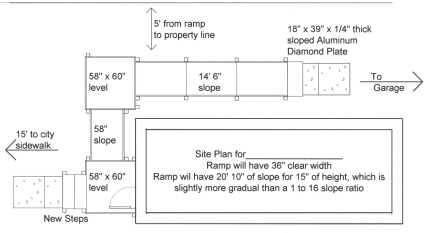
Is a building permit needed
for your ramp building project?
The only way to find out is to
contact the building code office for your community.
Telephone numbers are listed in the Government section of the phone book under Building Inspection or call the administrative office, and they will direct you. When speaking with local building code officials, be sure to inform them if the ramp will be temporary or permanent because this may have a bearing on whether or not a building permit is needed.
It is strongly advised that you work with the local officials because they can help you determine if a permit is needed, as well as with information regarding specific construction questions. If you do need a permit, it will be very helpful to have a site plan, elevation plan, framing plan, and estimated costs for the ramp. Information from this manual can be used in the application process. Be sure to take the engineering documentation with you for your plan review. (Sheets signed by Jeffrey Rudin, professional engineer, who created the documentation, are on page 43).
Ramp project personnel worked closely with local building officials and the Minnesota State Department of Administration during the design process to insure that the ramp design presented here is acceptable under Minnesota guidelines. Other states may differ in circumstances which may require variations in this design. Please check with your local officials before you begin a ramp.

During your plan review, the
building official may have an opinion regarding the slope at which
your ramp should be built. While the Minnesota codes for public
settings require a 1 to 20 slope
for outside ramps, and various design codes recommend a 1 to 12
slope, private homes
do not have to comply with those provisions.
(See "Other" on page 17).
The slope of the ramp you are building should be
determined by the needs of the user and a 1 to 20
slope may be appropriate.
However, a shorter ramp with a slope anywhere between 1 to 12
and 1 to 20
may also be appropriate.(
See the chapter on Design
for more information
on slope and other considerations.) You should be able to show
that the slope you have chosen is both safe and convenient for
the person using the ramp. If you wish to build a ramp that is
steeper than 1 to 20 and
the building official indicates that you cannot, you may wish
to refer them to Chapter 1340.0200 Subp.
2. A.
This information has been
distributed to building officials throughout Minnesota. Several
building officials have provided ideas and assistance during the
development of the Ramp Project. Local officials are available
to review your ramp plans. They can help you build the best ramp
possible to suit your needs.
The modular ramp design insures the strength and stability needed for safe use.
Changing or eliminating any of the components can reduce the structural integrity of the ramp and create dangerous situations
If you are building the ramp outside of Minnesota, be sure to check with your local building officials regarding this design and their requirements by law.